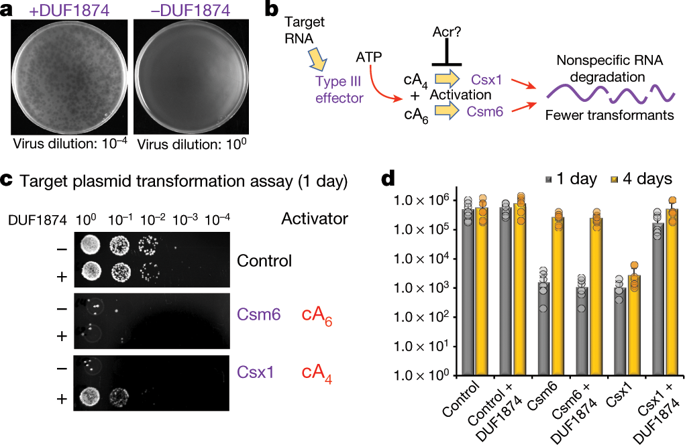Nature ( IF 50.5 ) Pub Date : 2020-01-15 , DOI: 10.1038/s41586-019-1909-5 Januka S Athukoralage 1 , Stephen A McMahon 1 , Changyi Zhang 2, 3 , Sabine Grüschow 1 , Shirley Graham 1 , Mart Krupovic 4 , Rachel J Whitaker 2, 3 , Tracey M Gloster 1 , Malcolm F White 1

|
The CRISPR system in bacteria and archaea provides adaptive immunity against mobile genetic elements. Type III CRISPR systems detect viral RNA, resulting in the activation of two regions of the Cas10 protein: an HD nuclease domain (which degrades viral DNA)1,2 and a cyclase domain (which synthesizes cyclic oligoadenylates from ATP)3,4,5. Cyclic oligoadenylates in turn activate defence enzymes with a CRISPR-associated Rossmann fold domain6, sculpting a powerful antiviral response7,8,9,10 that can drive viruses to extinction7,8. Cyclic nucleotides are increasingly implicated in host–pathogen interactions11,12,13. Here we identify a new family of viral anti-CRISPR (Acr) enzymes that rapidly degrade cyclic tetra-adenylate (cA4). The viral ring nuclease AcrIII-1 is widely distributed in archaeal and bacterial viruses and in proviruses. The enzyme uses a previously unknown fold to bind cA4 specifically, and a conserved active site to rapidly cleave this signalling molecule, allowing viruses to neutralize the type III CRISPR defence system. The AcrIII-1 family has a broad host range, as it targets cA4 signalling molecules rather than specific CRISPR effector proteins. Our findings highlight the crucial role of cyclic nucleotide signalling in the conflict between viruses and their hosts.
中文翻译:

一种抗 CRISPR 病毒环状核酸酶颠覆 III 型 CRISPR 免疫
细菌和古细菌中的 CRISPR 系统提供了针对移动遗传元件的适应性免疫。III 型 CRISPR 系统检测病毒 RNA,从而激活 Cas10 蛋白的两个区域:HD 核酸酶结构域(降解病毒 DNA)1,2和环化酶结构域(从 ATP 合成环状寡腺苷酸)3,4,5 . 环状寡腺苷酸反过来激活与 CRISPR 相关的罗斯曼折叠结构域6的防御酶,形成强大的抗病毒反应7,8,9,10,可以驱使病毒灭绝7,8。环状核苷酸越来越多地参与宿主-病原体相互作用11,12,13. 在这里,我们确定了一个新的病毒抗 CRISPR (Acr) 酶家族,可快速降解环状四腺苷酸 (cA 4 )。病毒环核酸酶 AcrIII-1 广泛分布于古细菌和细菌病毒以及原病毒中。该酶使用以前未知的折叠特异性结合 cA 4,并使用保守的活性位点快速切割该信号分子,使病毒能够中和 III 型 CRISPR 防御系统。AcrIII-1 家族具有广泛的宿主范围,因为它靶向 cA 4信号分子而不是特定的 CRISPR 效应蛋白。我们的研究结果强调了环核苷酸信号在病毒与其宿主之间的冲突中的关键作用。











































 京公网安备 11010802027423号
京公网安备 11010802027423号